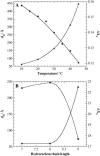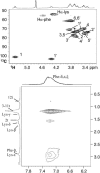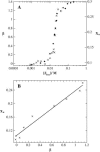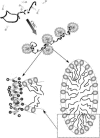Interactions between charged polypeptides and nonionic surfactants
- PMID: 16199501
- PMCID: PMC1366987
- DOI: 10.1529/biophysj.105.065342
Interactions between charged polypeptides and nonionic surfactants
Abstract
The influence of molecular characteristics on the mutual interaction between peptides and nonionic surfactants has been investigated by studying the effects of surfactants on amphiphilic, random copolymers of alpha-L-amino acids containing lysine residues as the hydrophilic parts. The hydrophobic residues were either phenylalanine or tyrosine. The peptide-surfactant interactions were studied by means of circular dichroism spectroscopy and binding isotherms, as well as by 1D and 2D NMR. The binding of surfactant to the peptides was found to be a cooperative process, appearing at surfactant concentrations just below the critical micellar concentration. However, a certain degree of peptide hydrophobicity is necessary to obtain an interaction with nonionic surfactant. When this prerequisite is fulfilled, the peptide mainly interacts with self-assembled, micelle-like surfactant aggregates formed onto the peptide chain. Therefore, the peptide-surfactant complex is best described in terms of a necklace model, with the peptide interacting primarily with the palisade region of the micelles via its hydrophobic side chains. The interaction yields an increased amount of alpha-helix conformation in the peptide. Surfactants that combine small headgroups with a propensity to form small, nearly spherical micelles were shown to give the largest increase in alpha-helix content.
Figures














Similar articles
-
The conformation of fusogenic B18 peptide in surfactant solutions.J Pept Sci. 2008 Apr;14(4):436-41. doi: 10.1002/psc.935. J Pept Sci. 2008. PMID: 17994609
-
Amyloid-β Peptide Interactions with Amphiphilic Surfactants: Electrostatic and Hydrophobic Effects.ACS Chem Neurosci. 2018 Jul 18;9(7):1680-1692. doi: 10.1021/acschemneuro.8b00065. Epub 2018 May 4. ACS Chem Neurosci. 2018. PMID: 29683649
-
Tuning of protein-surfactant interaction to modify the resultant structure.Phys Rev E Stat Nonlin Soft Matter Phys. 2015 Sep;92(3):032713. doi: 10.1103/PhysRevE.92.032713. Epub 2015 Sep 15. Phys Rev E Stat Nonlin Soft Matter Phys. 2015. PMID: 26465504
-
Interactions between surfactants and hydrolytic enzymes.Colloids Surf B Biointerfaces. 2018 Aug 1;168:169-177. doi: 10.1016/j.colsurfb.2017.12.002. Epub 2017 Dec 5. Colloids Surf B Biointerfaces. 2018. PMID: 29248277 Review.
-
Worm-like soft nanostructures in nonionic systems: principles, properties and application as templates.J Nanosci Nanotechnol. 2013 Jul;13(7):4497-520. doi: 10.1166/jnn.2013.7470. J Nanosci Nanotechnol. 2013. PMID: 23901470 Review.
Cited by
-
Shape variation of bilayer membrane daughter vesicles induced by anisotropic membrane inclusions.Cell Mol Biol Lett. 2006;11(1):90-101. doi: 10.2478/s11658-006-0009-3. Cell Mol Biol Lett. 2006. PMID: 16847752 Free PMC article. Review.
-
Structural insights into the combinatorial effects of antimicrobial peptides reveal a role of aromatic-aromatic interactions in antibacterial synergism.J Biol Chem. 2019 Oct 4;294(40):14615-14633. doi: 10.1074/jbc.RA119.009955. Epub 2019 Aug 5. J Biol Chem. 2019. PMID: 31383740 Free PMC article.
-
(De)stabilization of Alpha-Synuclein Fibrillary Aggregation by Charged and Uncharged Surfactants.Int J Mol Sci. 2021 Nov 19;22(22):12509. doi: 10.3390/ijms222212509. Int J Mol Sci. 2021. PMID: 34830391 Free PMC article.
-
Conjugated Nonionic Detergent Micelles: An Efficient Purification Platform for Dimeric Human Immunoglobulin A.ACS Med Chem Lett. 2024 May 15;15(6):979-986. doi: 10.1021/acsmedchemlett.4c00128. eCollection 2024 Jun 13. ACS Med Chem Lett. 2024. PMID: 38894919 Free PMC article.
-
Structural and dynamic properties of juxta-membrane segments of caveolin-1 and caveolin-2 at the membrane interface.Eur Biophys J. 2010 Jan;39(2):307-25. doi: 10.1007/s00249-009-0548-4. Epub 2009 Oct 22. Eur Biophys J. 2010. PMID: 19847421
References
-
- Kuroda, Y., Y. Maeda, S. Sawa, K. Shibata, K. Miyamoto, and T. Nakagawa. 2003. Effects of detergent on the secondary structures of prion protein peptides as studied by CD spectroscopy. J. Pept. Sci. 9:212–220. - PubMed
-
- Wieprecht, T., M. Beyermann, and J. Seelig. 1999. Binding of antibacterial magainin peptides to electrical neutral membranes: thermodynamics and structure. Biochemistry. 38:10377–10387. - PubMed
-
- Wieprecht, T., M. Beyermann, and J. Seelig. 2002. Thermodynamics of the coil-α-helix transition of amphipathic peptides in a membrande environment: the role of vesicle curvature. Biophys. Chem. 96:191–201. - PubMed
-
- Wieprecht, T., S. Rothemund, M. Bienert, and E. Krause. 2001. Role of helix formation for the retention of peptides in reversed-phase high-performance liquid chromatography. J. Chromatogr. A. 912:1–12. - PubMed
-
- Wieprecht, T., O. Apostolov, M. Beyermann, and J. Seelig. 2000. Interaction of a mitochondrial presequence with lipid membranes: role of helix formation for membrane binding and perturbation. Biochemistry. 39:15297–15305. - PubMed
Publication types
MeSH terms
Substances
LinkOut - more resources
Full Text Sources

